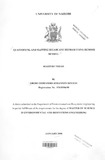| dc.description.abstract | The massive use of imported fossil fuels is a major cause of concern in Kenya. Energy from biomass could be used to address this problem. In the energy sector, sugarcane biomass can provide a safe, sustainable and potentially big source of energy that could trigger and sustain the industrialization process in Kenya. A sustainable biomass system forms a closed cycle of carbon increasing the importance of fuel from biomass in terms of global and regional environments. However, to tap this resource, requires the establishment of the temporal and spatial variability of the biomass distribution. There is also need to accurately determine the total amount of biomass that is available for use by the energy conversion systems in Kenya.
This study attempted to provide part of the answer to the question of spatial and temporal variability of biomass by developing a technique for quantifying and mapping sugarcane biomass using remote sensing in sugarcane fields within the Mumias Nucleus Estate. The technique developed aimed at providing a methodology for quantifying sugarcane biomass in real time to reduce inaccuracies, high costs and tediousness associated with the current physical crop cut census techniques.
The study was done and point at the existence of relationships between spectral reflectance measurements and leaf area index, vegetation cover and total aboveground green biomass. Pertinent crop biophysical parameters that included leaf area index, fractional photosvnthetic active radiation and leaf cover that characterize biomass in sugarcane fields were estimated from satellite image while spectral reflectance values were used in band combinations to calculate vegetative indices. Five vegetation indices [Normalized Difference Vegetation Index, Soil Adjusted Vegetative Index, Red/Near Infrared. Red/Middle infrared and Near Infrared/Middle infrared] were calculated and compared with in-situ ground truthed data clipped in two fields in Mumias Nucleus Estate.
Results indicated that biomass production and yield of a sugarcane crop could be quantified by satellite imagery by employing any of the vegetation indices investigated. The biophysical parameters (Leaf area index, fractional cover, and fractional photosynthetic active radiation) were also good quantifiers. Leaf area index and Red/Near infrared were the best biomass quantifiers with coefficients of correlation (r2) of 0.94 each. There also existed a strong relationship between the spectral values and field biomass with the best prediction having correlation coefficients (r2) of 0.78 and 0.82 for band 3 and band 4 respectively. Temporal maps of vegetation indices developed using transformed values of band 3 and band 4 suggested that yield and biomass could be determined by Enhanced Thematic Mapper (ETM+) satellite imagery over the senescence stage of sugarcane crop growth. The model developed performed well giving a coefficient of efficiency (Ccfr) between estimated and measured yields of 0.98 and an average relative percent error of 0.0175. The study showed that remote sensing provides fast data gathering over large areas and that these data sets may be used to estimate the final crop yield. This allows for practicing timely field management operations to yield, which is one of the major elements in biomass utilization. | en_US |



